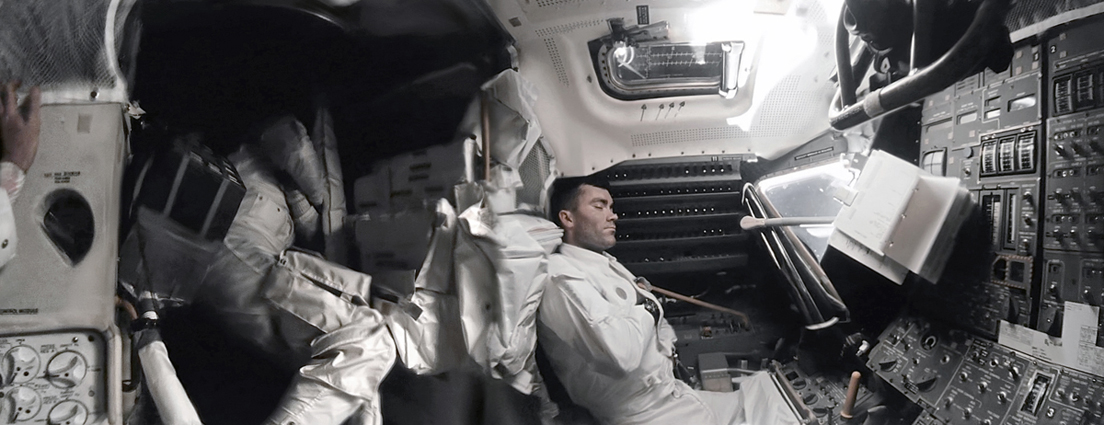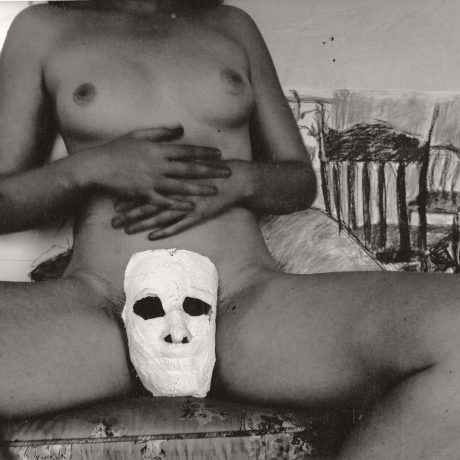
Andy Saunders’ Apollo Remastered series is unnervingly futuristic. The films from the 1968 to 1972 Apollo missions are highly protected, kept in a temperature-controlled vault in Building 8 at the Johnson Space Center, Houston. Many of the iconic images in print from these missions are replicas. Even the original photographs miss a lot of visual information due to their processing: the negatives themselves were more detailed than technology at that time could read.
The development of digital systems in recent years has allowed for better quality photographs. The original films have been revisited and digitally scanned, resulting in roughly 35,000 images. Seven years ago, Saunders began the massive task of remastering this vast archive as well as ten hours of 16mm movie footage.
In his final works, previously unseen details are brought into crisp definition, rendering the Apollo missions with a distinct 21st-century look and feel. Where the original images had a 1960s aesthetic, with sepia tones and grainy definition, Saunders’ remastered ones are punctured with crisp whites and an unbelievable amount of visual detail. Shadows are removed to reveal high-quality portraits, and faces are discovered in images that previously appeared entirely black.
“Where the original images had a 1960s aesthetic, Saunders’ remastered ones are punctured an unbelievable amount of visual detail”
Apollo 13 Napping Crew is one of the clearest examples of this. In the centre of the frame, Fred Haise of the ill-fated Apollo 13 mission takes a moment of rest at his chair in the Lunar Module. This module was used as a space “lifeboat” that the crew travelled back to Earth in after the service module’s oxygen tank exploded on the main spacecraft.
In Saunders’ panoramic image, Haise is cocooned by a mind-bending array of machinery and dashboards. “There are around 1,000 image samples in the panorama, taken from 36 separate frames of 16mm ‘movie’ footage, aligned, stacked, processed, and layered/merged into an image,” says Saunders.
In crisp definition and with a contemporary colour scheme, the image wouldn’t look out of place in a movie like Interstellar or Gravity. Despite its wide ratio, the set-up is claustrophobic. In the background, fellow astronaut Jack Swigert naps in the packed storage area. Just to the edge of the frame, mission commander Jim Lovell’s hand can be seen.
“In crisp definition and with a contemporary colour scheme, the image wouldn’t look out of place in movies like Interstellar or Gravity”
While Haise appears calm, the astronauts’ safe return was something of a miracle. The “lifeboat” was designed to support two people for two days. In this emergency situation it was required to support three men for twice that time. Cardboard, plastic bags and tape were utilised as a last-minute solution to attach lithium hydroxide canisters to an incompatible command module, removing carbon dioxide from the air and allowing the crew to travel safely home.
Saunders’ series conveys how progressive the missions are even now. More than 50 years later, when billionaires take day trips to space but no one has set foot on the moon since 1972, Apollo Remastered still has the power to inspire awe.
Emily Steer is Elephant’s editor
Apollo Remastered: The Exhibition is at The Royal Albert Hall, London, from 21 September to 1 November, and at the Glasgow Science Centre from 24 November 2022 to 16 April 2023. Apollo Remastered by Andy Saunders is published by Particular Books on 1 September 2022.






